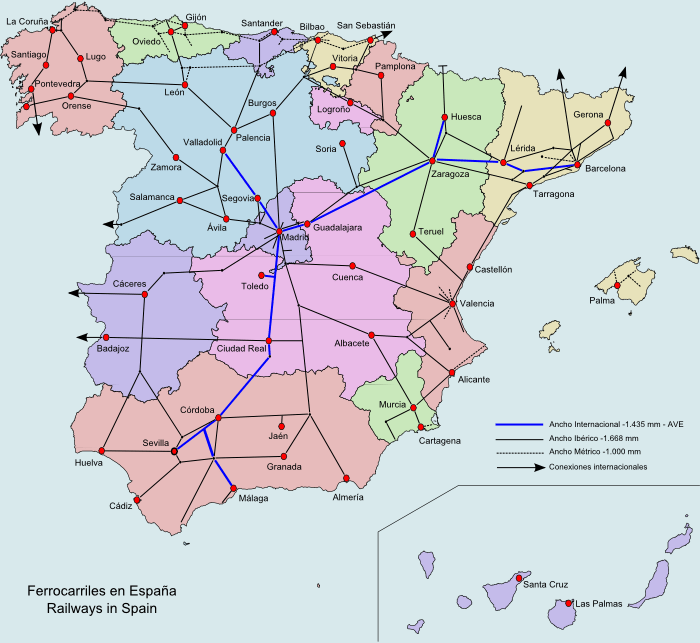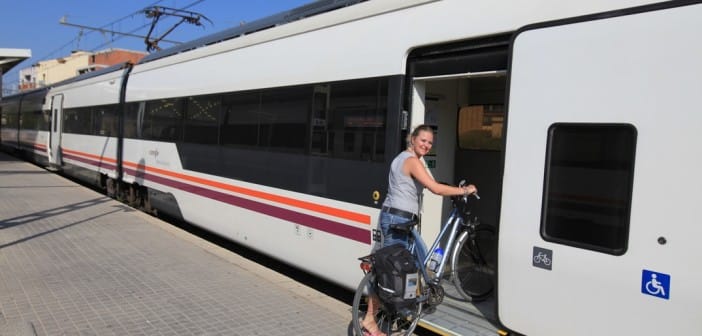- Rent a car in Spain
- Train and bus in Spain
- Sending a bike by parcel service in Spain
Rent a car in Spain
We have many years of experience in renting a car in Spain. We always rent via www.easyterra.com We have never been able to catch a mistake on that one before. Renting from Easyterra is always cheaper than renting locally or via the website of the individual landlords.
Picking up the car from the rental company at the airport in Spain can be annoying. You’ve completed your flight and want to move on as quickly as possible. When it’s busy at the landlord’s desk, it’s no fun. And if that desk is not at the airport itself, but in a parking lot outside it (which happens to the budget landlords), it certainly isn’t at all. It becomes even more annoying when the people behind the desk try to make you unsure about the insurances. Do you think you have arranged everything well at home, they come up with stories about things that are not insured? Damage to rims and glass, for example. Or the hoisting of your car in the event of a breakdown. Out of uncertainty, and to get rid of everything, many people at such a desk choose for an extra insurance.
At Easyterra, you can already choose the worry-free option at home. In that case, you can say resolutely at the bar in Spain that you do not need extra insurance. Sometimes we choose for worry-free and sometimes we don’t. We don’t mind having a certain deductible. As long as we know what the maximum deductible is when things go wrong.
Train and bus IN Spain
To get to the starting point of a cycle route in Spain, to avoid roads with heavy traffic, or to cross boring stretches, you can use buses and trains that allow bicycles. Planning a train trip is easier than planning a bus trip, because there are many different bus companies with their own rules.
1) Trains
Most trains are in the hands of one organisation, the state-owned company Renfe. Renfe does not have a very bike friendly reputation. On their website you will find departure and arrival times and prices of trains that allow bicycles. With the so-called Cercanías and the MD-trains (= media distancia, also called Regionales) you have a good chance, the latter with the exception of the TRD which does not allow bicycles. Cercanías are local trains near the big cities. An ideal way to get out of the city. Bicycle is free of charge.
The MD’s /Regionales are less often stopping, regional trains. If you see the logo of a bike on the side of a Regional, then you know that you are sitting well. At the place where the bike logo is located you can (easily) ride your bike inside. There is officially room for 3 bikes, but if the train is not too full, the conductor usually doesn’t mind if there are a few more. Bicycles are free of charge for distances up to 100 km. In addition, there is a surcharge of 3 Euro.
The AVANT is a middle distance high speed train. Bike are not allowed.
The long-distance trains (AVE, Largas Distancias) are not adapted to bicycles. On these train a bike is seen as special lugage. You have to take of the pedals and pack it. Maximum size of the pack 120x90x40. The bottom line is that you have to have your bike transported as a separate shipment and pack it
For times and prices of trains: https://www.renfe.com/EN/viajeros/index.html
2) Buses
Spain has a dense network of bus lines. All medium-sized and large towns have their own bus stations, which are often run by several bus companies. The regular services between larger villages and towns are usually provided by buses with sufficient luggage space. Usually two or three bikes can be used for this. It’s often free of charge. If it is not, you pay a supplement of a few euros up to a maximum of a tenner.
However, services between small, remote villages are provided by minibuses. With one bike, the luggage space is usually already full. Unfortunately on some routes there are also buses without luggage space that do not allow bicycles.
It is difficult to make a statement about taking your bike with you on the bus that applies to all companies in Spain. Still, you can hold on to the following:
A bike in the boot of a bus is almost always possible if you take out the front wheel and pack the bike+wheel in one way or another. You can do this by buying some (bulky) plastic to protect your bike. With a roll of tape you keep the plastic in place.
A visitor to our site wrote:
Bicycle transport in buses? Indeed: there is a lot you can do in the cargo space, if you remove the pedals, steer flat, remove the front wheel.We then wrapped our bikes in a (unrolled) roll of garbage bags-with-tape. Later we got the tip: cling film! Then you don’t need tape. The only thing that matters is that the chain + sprockets are protected, both for your own bike and for the luggage of others.
Bicycle by parcel service in Spain
Do you want to transport your bike by courier within Spain? SEUR company is experienced in this field. Their standard packaging goes up to 20 kilos. The site on which you fill in all your data is in English and you can pay by credit card. If you get the Spanish site in front of you, click on idiomas and choose a language that you find easier. Costs for transport of a bicycle in Spain are around € 50,-. SEUR has offices in a large number of locations. You can check there if they can arrange bike boxes for you. http://www.seur.com/en/index.do.
SEUR can also ship you bike to your homeland. This is what they claim on their website:
At SEUR we transport your bicycle wherever you like, for €49.99 (including packaging, special taxes not included) for domestic shipments, and from €77.55 for international shipments. Find out more at your nearest point of sale.


